![]() MARK GARDINER (with help
from Neil Mackenzie)
MARK GARDINER (with help
from Neil Mackenzie)
![]()
Day Five - Wednesday 23 May
This time our target area was the cemeteries from Ploegsteert Wood to the French border north of Armentieres, and as far west as Nieuwkerke. As we left Ypres visibility was poor with a heavy mist, particularly thick ion the folds of the ground, but by the time we reached Ploegsteert Wood the mist had burned off and we had a brilliantly sunny day.
We parked at our first cemetery of the day, Prowse Point Military Cemetery, to cover the area in and around Ploegsteert Wood on foot. This is a beautiful spot, overlooking the wood, and at this time of the morning the peace and quiet was only marginally disturbed by the CWGC gardeners who had started work even before we'd arrived, although a coach party followed us soon after. We were visiting: -
Private P Emmett of 2nd Bn. Royal Dublin Fusiliers, of whom we know little except his widow lived in Dublin and he died on 7 December 1914 - as the cemetery was started by his battalion in November 1914 it's reasonable to assume he was one of the first burials.
Serjeant Arthur Dale MM & Bar of 2nd Bn. Rifle Brigade, who as a 22-year old miner from Sheffield when he enlisted in September 1914. He has suffered gunshot wounds in May 1915, and was awarded his Military Medal (along with 6 others) for an action on 24 November 1916, possibly when his battalion attacked at Les Boeufs on 23 October 1916 He was killed in action on 25 September 1917 at St. Yves in the Warneton sector (now nearby Saint-Yvon) when there was some slight shelling and mineworkers landed on the front line trenches. Serjeant Dale was awarded a Bar to his MM two days later for action to the east of Ypres, neat Westhoek Ridge, on 15-17 August 1917 - the award being gazetted on 2 November 1917.
Visible from Prowse Point, being just a short walk down the slight slope towards the wood, is Mud Corner Cemetery, which is a small but equally pretty cemetery almost exclusively the preserve of Aussies and Kiwis; note that the cemetery register is held at Prowse Point. We were visiting Private James Rossi of 15th Bn. Australian Infantry who was a hairdresser from Brisbane. He enlisted in May 1916, left Australia on 21 October 1916, landed at Plymouth on 10 January 1917 and joined his unit in France on 27 May 1917. He was killed in action on 4 July 1917 with the Red Cross report stating: "I saw Pte. Jess Rossi of A Coy blown to pieces at Plugstreet when in support early in July 1917. I helped to dig his body out and saw his grave later at Prowse Point, Hill 63…." … "He was a barber by trade and I think that the shop where he worked was opposite Brunswick Street Railway Stn. He was in A Coy, 1 Platoon. He was killed on night of July 3rd (it appears his body was dug out the next day) at about 8.30pm in the subsidiary line at Plugstreet…… 32 dud shells came over and then 5 which burst." Killed by the same shell was Private James Booth, who is buried in the neighbouring grave.
We then walked along a bridleway and entered Ploegsteert Wood.
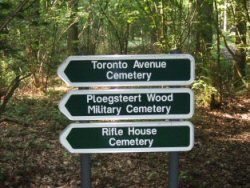
The first cemetery within the wood is Toronto Avenue Cemetery, which is totally enclosed by the trees, making it appear dark and gloomy with the sun unable to break through, a factor that undoubtedly is the major cause of the poor state of the grass, which needs renovation. The name is derived from one of the paths in the wood rather than the burials within, as they are all Australian casualties from the Battle of Messines. One of these was Serjeant Beresford Norman of 36th Bn. Australian Infantry who was killed on 9 June 1917. He was born in Northumberland but his family had emigrated to New South Wales. An ironmonger, he enlisted in January 1916 after passing NCO school, arriving in France in November 1916. He was a popular Serjeant regarded as "reliable, sound and tactful." In charge of No. 3 Platoon in A Coy, during the attack on Messines they were in reserve and early in the morning of 9 June 1917 a German plane came over and spotted the crowded trench. 5 minutes later a 7.2" shell killed Norman and another (possibly one of Schipper, Macaulay or McCauliffe, who died on same day and are buried here) and wounding 19.
Further into the wood is Ploegsteert Wood Military Cemetery which is slightly larger than Toronto Avenue, so gets more sun, and as a result is a pleasing sunlit sylvan glade. So far removed from the horrors of war. Buried here is Captain Robert Orr of 3rd Bn. Somerset Light Infantry, who was killed on 19 December 1914 whilst attached to 1st Bn. He was a 34-year old from Newcastle, County Down, Ulster; there was a family firm of solicitors. He was killed during an attack in the area of the Birdcage which reached the St. Yves - Le Gheer road, but the ground was unsuitable for digging trenches, so his unit fell back to their positions in Ploegsteert Wood, where the Royal Engineers had erected breastworks. British shells had fallen short during the attack and inflicted friendly-fire casualties, whilst straw mattresses were used to cross the uncut German wire.
Rifle House Cemetery is very similar - peaceful and charming in the sun. We were visiting: -
Serjeant Ralph Seward of 21st Bn. King's Royal Rifle Corps, who enlisted in Birkenhead on 27 September 1915 aged 19. He died on 1 June 1916 whilst his battalion was in billets finding working parties for the front line and support trenches held by the 15th Bn. Hampshire Regiment; the war diary states that casualties in the period 1-5 June 1916 were 3 wounded in a communication trench, 16 wounded in billets in the wood caused by shrapnel, and 1 (killed / wounded?) by a stray rifle bullet in the wood.
Private T Sharman of 1st/4th Bn. Oxfordshire & Buckinghamshire Light Infantry on the 92nd anniversary of his death (23 May 1915).
The walk encompassing all five cemeteries in and around Ploegsteert Wood took about an hour and we were lucky that it was perfect weather. Back in the car to Lancashire Cottage Cemetery, which although being sited on the side of a busy (by Belgian standards) road is remarkably tranquil, or so it seemed in the early summer sun. There are good views of the southern edge of Ploegsteert Wood, and although the cemetery appears to be not that well frequented by visitors, it is kept in superb condition. We were visiting: -
Serjeant Evan Warner of 5th Bn. London Regiment (London Rifle Brigade), whose family came from Waddon House, Croydon. He had been at Whitgift Grammar School 1893-97 and was a keen swimmer and water-polo player, before joining the London Rifle Brigade in 1904 and taking part in their record-breaking march to Brighton (as quoted by the Whitgift Roll of Honour). He was sent to France in November 1914 before being killed by a sniper on 11 December 1914 aged 34.
Lieutenant Percival Hugh Trench Hoare of 3rd Bn. East Lancashire Regiment. Born in January 1888, he attended Eton, was a motor engineer by trade and had spent time in Mexico. He married Irene at Truro on 10 October 1914 and was actually serving with 1st Bn. which he joined on 21 December 1914 when they were stationed at Le Gheer, just in time for the unofficial Christmas truce. He died of wounds on 2 January 1915 during a period of heavy sniping and was originally buried at the side of the Polyester - Le Gheer road, which could well be where the cemetery is sited as it was begun by his battalion. His son was born on 14 September 1915 (!) and was named after him.
After passing through Ploegsteert our next stop was at London Rifle Brigade Cemetery, another one sited on a busy road (towards Armentieres), but this time a long and narrow plot running away from the roadside, again immaculate with flowers blooming. We were visiting: -
Rifleman Cuthbert Young of 5th Bn. London Regiment (London Rifle Brigade) from Ventnor, Isle of Wight. He was another old boy of Whitgift Grammar School, attending in 1906-07, and it is said he was an immensely popular football player. He joined the London Rifle Brigade in August 1914 and acted as a scout; he was shot by a sniper whilst carrying despatches from the front line to HQ on 6 March 1915 aged 23. He was awarded 1914 Star & Service Medal.
Serjeant Francis Winch of 8th Brigade Australian Field Artillery who was a publican of the Red Bluff Hotel in Sandringham, Victoria. He enlisted in January 1916, left Melbourne in May 1916 and landed at Plymouth in July 1916, before embarking for France on 30 December 1916. He was in charge of "A" sub-section 108th Howitzer Battery and was lunching in the mess on 23 May 1917 when a 5.9" shell burst mortally wounded him in the back and lungs, and he died 20-30 minutes later at a dressing station aged 32.
The next cemetery, Gunners Farm Military Cemetery, appears to be seldom visited as it's off the beaten track between Ploegsteert and Armentieres. We were visiting: -
Private Herbert Williams of 76th Field Ambulance, Royal Army Medical Corps. He lived relatively locally to the two of us, the family coming from Thornton Heath in Surrey. He died on 26 October 1915 aged 24.
Second Lieutenant Frederick Enderbury of 10th Bn. Highland Light Infantry, who was originally from Smethwick near Birmingham. He had enlisted in 17th Lancers in 1900 for 7 years with 5 years reserve, although he extended his service period to 21 years in 1911. He saw active service in South Africa in 1901-02, attended several army schools gaining regular promotions, and was based in India from September 1905 to October 1914, before landing in France in November 1914. He was commissioned into the Highland Light Infantry in November 1915, and was killed in action at Le Bizet on 9 February 1916 aged 32.
Just a few yards along on the opposite side of the road is Calvaire (Essex) Military Cemetery, another lightly visited resting place but one which is beautifully maintained. The last visitors two months ago had been the family of Captain Robert Pillman of 10th Bn. Queen's Own (Royal West Kent Regiment), who came from Kent and played rugby union for Blackheath, gaining an international cap for England against France in 1914, as well as being a keen golfer. A solicitor's clerk who enlisted in 10th Bn. Royal Fusiliers on the outbreak of war, before being commissioned into the West Kent's in July 1915. The war diary states he was badly wounded during a reconnaissance raid on 8 July, being brought back in by his men from the German front line trench, before dieing the next morning.
Our next cemetery proved difficult to find, as when only a few hundred yards from it we found the road was closed, and when retracing our steps some inadequate road signs and map-reading (Neil's fault this time!) led us to end up in the wrong country! Finally we found the small Le Touquet Railway Crossing Cemetery which is very pretty with plenty of flowers and shrubs, especially rhododendrons, but the garden ambience was spoiled by its location on a busy road junction with heavy plant and equipment at work a few yards away.
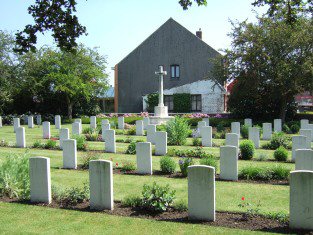
There is no registry box. We were visiting one of the earliest British casualties in the area: Rifleman Frederick Wren of 1st Bn. Rifle Brigade, whose family hailed from Caterham, Surrey. A regular soldier who had enlisted in September 1906, he had several medical and disciplinary problems, including a sentence of 9 months detention for striking an officer in the execution of his duty in 1911 (3 months were commuted). On 30 October 1914 his unit were in the trenches south of Le Gheer when, despite heavy enemy shelling, the German attack was beaten off by British artillery fire; Rfm. Wren was killed aged 29. There are several casualties from that day buried here, including the Boer War veteran Capt. Otto Gilliat.
Tancrez Farm Cemetery is tucked away behind houses, and it is difficult to park on the busy road - there are plenty of lorries. The flowers are beautiful, but the state of the headstones varies: some have aged badly, whilst others in seemingly more exposed positions are less weathered. We were visiting: -
Private Stephen Perry of 7th Bn. East Surrey Regiment, from Camberwell, who had enlisted in 1904 aged 18 for 3 years service with 9 years in reserve. There were disciplinary problems and when he was transferred to the Army Reserve in 1907 it was noted that his conduct was indifferent but had shown signs of improvement latterly. He went to France in August 1914 but returned to England in January 1915; his disciplinary problems continued in May 1915 when he went absent twice, being sentenced to 10 days confined to barracks and fined 10 days pay, so it is surprising that on 14 June 1915 he was promoted to Lance Corporal in the 3rd Battalion, before being transferred to the 7th Battalion the following day and reverting to Private. He joined his battalion at Bailleul on 18 June 1915, and was killed in action on 18 July 1915.
Private JH Williams of 2nd Regiment South African Infantry, from Durban, natal, who died on 23 May 1916 aged only 16.
Motor Car Corner Cemetery is a rather plain but well-maintained cemetery - the mole traps are very effective as we found one victim - and has many New Zealand graves. One of these is the resting place of Private Victor Adams of 3rd Bn. Wellington Regiment, N.Z.E.F. He was a freezing works hand from Napier who embarked for Plymouth on 15 November 1916. On the night of 16-17 July 1917 Taranaki advanced post, in the Le Touquet sector, made contact with a German patrol, suffering two wounded; presumably one was Pte. Adams who died of his wounds aged 20.
Next is the tale of the cemetery that got away. We were aware that there were a small number of CWGC graves in Le Bizet Cemetery, Armentieres, and thought we had pinpointed this cemetery from the details online as being a large municipal cemetery in Le Bizet. The town is split by the Franco-Belgian border (the town centre car park is in France, the main street 20 yards away is in Belgium), and it took us some time to find the cemetery; it took us even longer to thoroughly confirm to our dissatisfaction that there were no CWGC graves present. A later check revealed that Le Bizet cemetery as referred to is actually about a kilometre to the south, across the border in France on the northern outskirts of Armentieres, and therefore outside of our original frame of reference. This did, however, add up to a frustrating hour or so.
So onto another communal site at Ploegsteert Churchyard where we were pleasantly surprised to find a tiny, self-contained grassed plot, with retaining hedge and bronzed gate, in the middle of a large civil burial ground. As expected there was no registry box. We were visiting two Canadian soldiers from the 7th Bn. Canadian Infantry (British Columbia Regiment) who died on the same day, 26 February 1915: -
Lieutenant Herman Beaumont Boggs aged 22 from Victoria, British Columbia, a law student with two years in the Victoria Fusliers, who had enlisted in September 1914; and: -
Private Thomas Sutton also aged 22 who was born in Stockport, Cheshire, a sailor who had trained with 104th Infantry and also enlisted in September 1914.
The regiment had entered the trenches at Ploegsteert on 21 February 1915 for trench instruction with the East Lancashire and Hampshire regiments. Boggs and Sutton were killed 5 days later, the first casualties suffered by the 7th Battalion in the war.
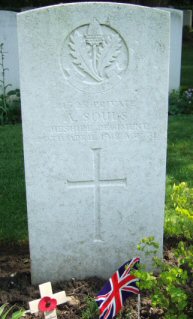 |
Avoiding a large number of cycling clubs, many seemingly training schoolchildren, we headed back towards Ploegsteert Wood and the roadside site of Strand Military Cemetery, which is surprisingly larger (over 1,000 graves) than it first appears. Buried here is Private Alfred Souls of 11th Bn. Cheshire Regiment, one of five brothers from Great Rissington who fell in the Great War. Alf was the fourth to die, being killed aged 30 on 20 April 1918 during a rearguard action at Ploegsteert Wood in the last German offensive. It is said the fifth brother, Arthur, then lost the will to live and died a week later whilst serving with the Royal West Kent's at Villers-Bretonneux. |
Unusually the café at Hyde Park Corner was closed, so we ate a packed lunch in the shade at the site of our next three sites. Hyde Park Corner (Royal Berks) Cemetery is a small roadside plot opposite the Ploegsteert Memorial, which is where the cemetery register is kept. We were visiting: -
Lieutenant Ronald Poulton-Palmer of 1st/4th Bn. Royal Berkshire Regiment, the unit which had started the cemetery. Born in Headington on 12 September 1889, educated at Oxford University, he played rugby union for the Barbarians and Harlequins. He eventually became captain of England and in a match against France in 1914 he scored four tries. He became chairman of the Huntley and Palmer biscuit business in Reading but on the outbreak of the First World War he immediately volunteered for the Royal Berkshire Regiment. He arrived on the Western Front in March, 1915. He was killed at Ploegsteert Wood on 12:20 a.m. in the morning of 5 May 1915 being struck by either a stray bullet or a sniper (believed to be the former as the moon had yet to rise) whilst superintending work on the trenches from the roof of a dug-out. The bullet entered his right side just below the armpit, and he was killed instantaneously. He was buried in Ploegsteert Wood close to Hyde Park Corner. A fellow officer reported that when he went round the company at dawn "almost every man was crying". Poulton-Palmer was one of 26 England rugby international players killed in the war. A further 30 Scottish internationals also lost their lives during the conflict. His last words reputed to be "I shall never play at Twickenham again" although another account says he died without speaking. We believe that he was killed at or near the farm just across the road from Prowse Point.
Private Harry Toft of 26th Bn. Royal Fusiliers who is commemorated on the London Joint City & Midland Bank memorial at Canary Wharf. He was killed on 7 June 1916 aged 23. The war diary states: "Patrol visited ruins of Machine Gun House at U 15 b 3.5 1 and found a small room with sandbags and loop holes (snipers post). Front line shelled rather severely and MG and rifle fire active. During day enemy put up notice board which read "Kitchener has been taken by the Devil". Aircraft active on both sides. 1 killed, 2 wounded."
The cemetery immediately opposite is Berks Military Extension, an extensive burial ground separated into two distinct plots by the memorial to the missing, which also houses the cemetery register. It is very well maintained. We were visiting: -
Private Percy Darvill of 26th Bn. Royal Fusiliers, who died on 17 July 1916 whilst in the trenches in front of the Birdcage.
Serjeant Peter Annis DCM of 54th Coy. Royal Engineers. From Cork, educated at Duke of York's Royal Military School and Royal Hibernian Military School, a bricklayer by trade, he enlisted in Lowestoft in January 1904. He fathered an illegitimate child in June 1913, marrying Emily O'Sullivan in November 1913. His DCM was gazetted in August 1916 for "constant good work throughout the war; he has always set an excellent example to his section in billets and under fire." He was killed in action on 4 October 1916 aged 32.
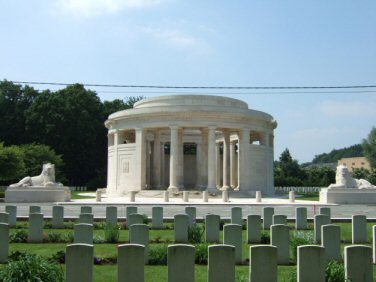
The Ploegsteert Memorial is a very impressive rotunda with over 11,000 missing recalled here but, as usual with these memorials, the names are becoming less defined and more difficult to clearly make out over time. The three soldiers commemorated here we were particularly remembering were: -
Rifleman Reginald Tucker of 16th Bn. London Regiment (Queen's Westminster Rifles) who attended Whitgift Grammar School 1905-07. He joined Queen's Westminster Rifles on outbreak of war; after 2 months training sent to France where he was shot through the head whilst in the trenches on 4 December 1914 aged 21. His captain wrote: "He was an extraordinarily plucky fellow, doing his best to keep down the enemy's fire, even when at its heaviest. We shall always remember him among us as the first man to fall fighting for England."
Private Leonard Clack of 2nd Bn. South Wales Borderers from Beddington, Surrey, who attended Whitgift Middle School and died on 11 April 1918 aged 21.
Private Arthur Bucknell of 13th Bn. East Surrey Regiment who died on 9 April 1918 during the German attack on the La Fleurbaix sector. At 4.15am the enemy opened an intense bombardment on the British front and support line and also heavily shelled back areas. The East Surrey's stood to but the enemy broke through the Portuguese on the right flank and the battalion was surrounded. The men who fought their way out formed a line on the south side of the River Lys and later took up position in a Reserve line at Le Petit Mortier. The casualties were: killed Capt G Beaumont (also on Panel 6) and 7 other ranks; wounded 1 officer and 80 other ranks; missing 18 officers and 437 other ranks (including Pte. Bucknell).
Underhill Farm Cemetery is another away from the better known areas in the Salient, so isn't heavily visited and is a quiet, tranquil place. We were visiting: -
Corporal Henry (Harry) Cliff of 8th Canadian Raliway Troops. Born in Torquay in December 1888 who had previously served with 7th Bn. Worcestershire Regiment. A railway foreman, he had originally enlisted in Calgary in October 1916 with 211th Bn. (Alberta Americans) part of the 'American Legion' which originally intended to recruit a Brigade of Americans for the C.E.F. The 211th amalgamated with the 218th (Edmonton Irish Guards) to form the 8th Canadian Railway Troop. He was killed aged 28 on 5 June 1917, possibly when the Seaforth Line was shelled (or gassed).
Private Frederick Lycett of 46th Bn. Australian Infantry who had been born in Hartlepool but whose family had emigrated to Ascot Vale, Victoria. A pattern maker, he enlisted in August 1916 (his parents had to give consent as he was under 21), eventually joining the battalion on 10 July 1917. On 18 July 1917 acting as fatigue and working parties the unit was based on Hill 63 which was severely shelled with high explosive, shrapnel and gas for over 4 ˝ hours; however very few casualties were reported, one of which was Pte. Lycett.
Some distance away in the border village of Romerin is Maple Leaf Cemetery named by the 3rd Canadian Field ambulance based there. This is well off the tourist route and seems to have had very few visitors, but it is a pretty place with flowers nearing full bloom. We were visiting Lieutenant Arthur Norton Hickling Churchill of 1st Bn. Canadian Infantry (Western Ontario Regiment) who was born in Somerset in 1891 and been in the OTC at Clifton College before farming in Canada. He was in the Canadian Dragoons before enlisting in September 1914, and being commissioned into 1st Bn. as machine-gun officer. On 5 September 1915 the battalion were holding Gloucester House and Showery trenches when Lt. Churchill was seriously wounded, dieing two days later; the battalion paraded for his funeral at Romarin on 9 September.
As usual there was no registry box at Nieuwkirke Churchyard but the CWGC plot is a long, narrow grassed area along the edge of the civilian plot, with most headstones being heavily weathered. We were visiting Second Lieutenant Charles Loxton of 1st/5th Bn. North Staffordshire Regiment on the anniversary of his death. Born in 1892 from Cannock, he attended Harrow School and Oxford University, and was commissioned in August 1914. Arriving in France on 3 March 1915. Soon after midnight on 23 May 1915 he was with his men repairing wiring in front of trench when he was struck by a bullet and died in the ambulance.
Some distance into the countryside is Westhof Farm Cemetery, which gets few visitors thanks to its location; its hillside position gives great views but many of the headstones have worn badly. We were visiting Captain Walter Ball Dyke of 155th Siege Battery, Royal Garrison Artillery, who hailed from Somerset but is commemorated on the Coulsdon War Memorial. He applied for a temporary commission in September 1914 and disembarked at Le Havre in August 1916, often operating as Second in Command of his battery. On 10 April 1918 there was a heavy enemy bombardment followed by an infantry attack, and the battery was heavily shelled with high explosive and gas whilst firing on SOS targets. Capt. Dyke was killed aged 21 whilst bringing up ammunition to the guns.
As we'd made good time today, and the weather was perfect, we decided to take in one of our most favoured cemeteries on the way back into town.
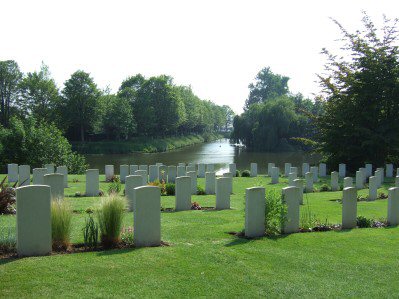
Ramparts Cemetery, Lille Gate has a beautiful backdrop of Ypres's defensive moat and trees. We were visiting Rifleman Harry Joynson of 6th Bn. The King's (Liverpool Regiment), an accountant from Wallasey, who enlisted with his brother on 10 August 1914. He was killed on 18 April 1915 whilst a member of a ration party that was shelled; he was 23.
We'd covered 44˝ miles over 8˝ hours.
The Last Post ceremony was well attended and some of the school girls laying wreaths this evening were crying by the end. Again neither of us can recall where we ate that evening, but we did get back to Le Chat Noir in time to be bored to death by the European Cup Final.
| Continue reading the Salient Tour Account - DAY 6 |
![]()
 Copyright © Mark Gardiner,
March, 2008
Copyright © Mark Gardiner,
March, 2008
Return to the Contents Section